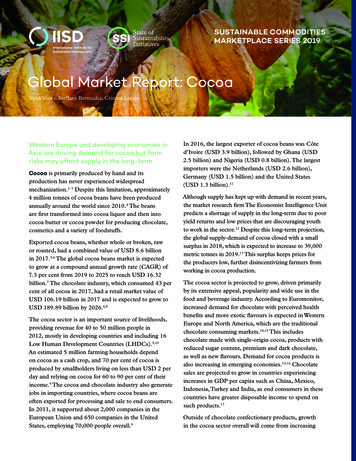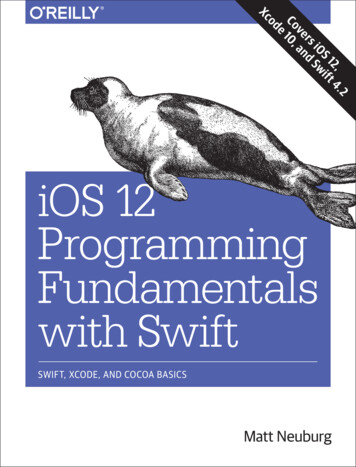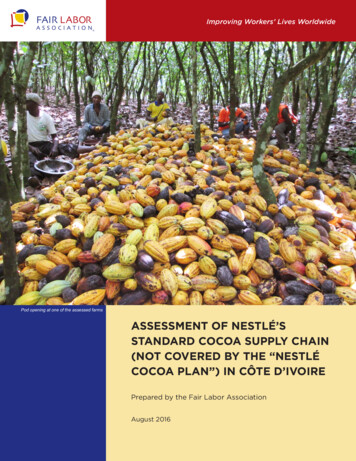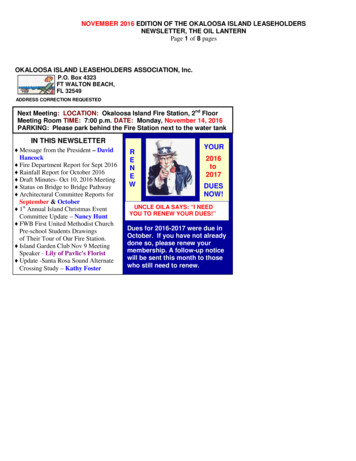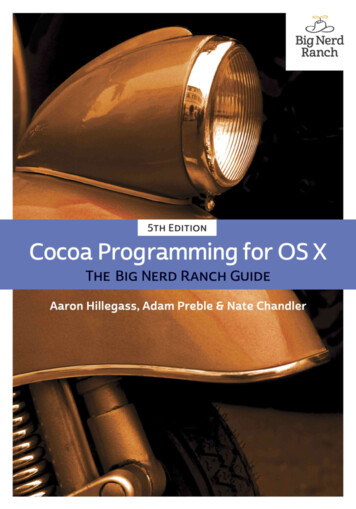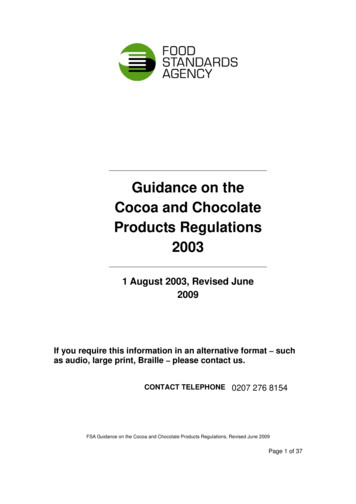
Transcription
Guidance on theCocoa and ChocolateProducts Regulations20031 August 2003, Revised June2009If you require this information in an alternative format – suchas audio, large print, Braille – please contact us.CONTACT TELEPHONE 0207 276 8154FSA Guidance on the Cocoa and Chocolate Products Regulations, Revised June 2009Page 1 of 37
SummaryIntended audience:All food businesses in the UK involved in the manufacture orsale of chocolate and cocoa products. Enforcement Officerswill also find it useful.Regional coverage:This guidance is applicable to England, Scotland, NorthernIreland and Wales.Purpose:Cocoa and chocolate products are governed by compositionaland labelling requirements. This guidance helps those workingin the relevant industries to understand the Regulations andfulfil the requirements established by the legislation.Legal status:This guidance is intended to: accompany the Regulationsand address best practiceEssential actions to ¾ In order to label a product as chocolate the reserveddescriptions for designated cocoa and chocolate productscomply with themust be used.regulations (s):¾ The minimum compositional requirements for essentialingredients of chocolate and cocoa products must be met¾ Chocolate products must be labelled with a declaration ofthe cocoa solids and (if applicable) milk solids in the formprescribed.¾ If chocolate products use any of the 5 vegetable fatsauthorised this must comply with the maximum levelpermitted and be declared on the label.¾ Cocoa and chocolate products must comply with therequirements of the Food Labelling Regulations 1996 (asamended).FSA Guidance on the Cocoa and Chocolate Products Regulations, Revised June 2009Page 2 of 37
REVISION HISTORYThis guidance follows the Government Code of Practice on Guidance. If you believethis guidance breaches the Code for any reason, please contact us using the numberon the front sheet. If you have any comments on the guidance, again please contactus on the number on the front sheet.RevisionNo.Revision date1June 2006To clarify the use ofsweetenersRichard WoodJune 2009To correct the interpretation onthe declaration of cocoa solidsin filled chocolates andpralines.To update the format of thedocument.Elise Hughes2Purpose of revisionRevised byFSA Guidance on the Cocoa and Chocolate Products Regulations, Revised June 2009Page 3 of 37
CONTENTS1.2.3.4.5.6.7.REGULATIONS REFERRED TO IN THIS GUIDANCEINTENDED AUDIENCEPURPOSE AND LEGAL STATUSPURPOSE OF THE LEGISLATIONSCOPE OF THE REGULATIONS5.1.PRODUCTS COVERED BY THE REGULATIONS5.2.PRODUCTS OUTSIDE THE SCOPE OF THE REGULATIONS5.3.ADDED INGREDIENTS5.4.USE OF ADDITIVES IN DESIGNATED PRODUCTS5.5.LIQUEUR CHOCOLATES5.6.DESCRIPTIONS OF FOOD HAVING CHOCOLATE FLAVOUR9.10.88991010CALCULATION OF PERCENTAGESVEGETABLE FATS OTHER THAN COCOA BUTTER7.1.8.566681111TOTAL FAT CONTENT – MILK CHOCOLATE AND FAMILY MILK CHOCOLATELABELLING OF CHOCOLATE PRODUCTS8.1.RESERVED DESCRIPTIONS8.1.1.MILK CHOCOLATE AND FAMILY MILK CHOCOLATE8.1.2.LABELLING OF ‘DARK CHOCOLATE’, ‘PLAIN CHOCOLATE’ ETC8.1.3.LABELLING OF FILLED CHOCOLATE8.2.VEGETABLE FATS DECLARATION8.2.1.PRODUCTS REQUIRING A VEGETABLE FAT DECLARATION8.2.2.PRODUCTS NOT REQUIRING A VEGETABLE FAT DECLARATION8.3.MILK SOLIDS DECLARATION8.3.1.MEANING OF ‘MILK SOLIDS CONTENT’8.4.MEANING OF ‘SUGAR’8.5.COCOA SOLIDS DECLARATION8.5.1.COCOA SOLIDS DECLARATIONS FOR GIANDUJA CHOCOLATE – A SPECIAL CASE8.5.2.COCOA SOLIDS DECLARATIONS FOR CHOCOLATE A LA TAZA – A SPECIAL CASE8.5.3.PRODUCTS NOT REQUIRING COCOA SOLIDS DECLARATION8.6.COCOA INGREDIENT DECLARATIONS FOR COCOA POWDER8.7.PRODUCTS SOLD IN ASSORTMENTS8.8.QUALITY DESCRIPTIONS FOR CERTAIN CHOCOLATE PRODUCTSGENERAL LABELLING PROVISIONS9.1.MANNER OF MARKING – GENERAL RULES9.2.MANNER OF MARKING – FLEXIBLE PROVISONS9.3.QUANTITIVE INGREDIENT DECLARARTIONS – QUID, SPECIAL EMPHASIS9.4.DURABILITY INDICATION9.5.SEASONAL SELECTION PACKSOFFENCES AND PENALTIES10.2.RESPONSIBILTY FOR ENFORCEMENT10.3.DEFENCE IN RELATION TO EXPORTS10.4.TRANSITIONAL 262727ENFORCEMENT ISSUES10.1.1314272728282811.CONTACTSANNEX A SCHEDULE 1 COCOA & CHOCOLATE PRODUCTS & THEIR RESERVED DESCRIPTIONSANNEX B SCHEDULE 2 AUTHORISED VEGETABLE FATSANNEX C EXAMPLES OF PRODUCT LABELLINGFSA Guidance on the Cocoa and Chocolate Products Regulations, Revised June 2009Page 4 of 3729303637
1. REGULATIONS REFERRED TO IN THIS GUIDANCEThese Guidance Notes cover separate but parallel Regulations in all fourcountries of the UK.Details are below of how the Regulations are referred to in the text, plus the fullname and number of the respective Regulations in each country.The Cocoa and Chocolate Products RegulationsThe Cocoa and Chocolate Products (England) Regulations 2003 (SI 2003/1659)The Cocoa and Chocolate Products (Scotland) Regulations 2003 (SI 2003/291)The Cocoa and Chocolate Products Regulations (Northern Ireland) 2003 (SR 2003 No.313)The Cocoa and Chocolate Products (Wales) Regulations 2003 (SI 2003 No 3037 w.285)In addition, all products covered by the Regulations must also comply with thegeneral provisions of the Food Safety Act 1990, under which all food legislation inGreat Britain is made¹, and the general rules governing the labelling of foods laiddown by the Food Labelling Regulations 1996 (as amended)² (FLR) (see section 9below).¹ In Northern Ireland, the equivalent legislation is the Food Safety (Northern Ireland)Order 1991.² Separate, equivalent Food Labelling Regulations apply in Scotland, Wales andNorthern Ireland.Following the process of devolution, food legislation is now commonly made on aseparate basis in England, Scotland, Wales and Northern Ireland. This is the casewith the four separate sets of Chocolate Regulations. Therefore the EnglandRegulations apply only in England; the Scotland Regulations apply only in Scotland,and so on.However, the four sets of Regulations differ only in the powers under which they aremade, and the food authorities given responsibility for enforcement. The provisionsrelating to cocoa and chocolate products are in practice identical in each of the fourcountries.FSA Guidance on the Cocoa and Chocolate Products Regulations, Revised June 2009Page 5 of 37
2. INTENDED AUDIENCEThis guidance is intended for use by all food businesses in the UK involved inthe manufacture or sale of chocolate and cocoa products. EnforcementOfficers will also find it useful.3. PURPOSE AND LEGAL STATUSCombination of regulatory and best practice guidanceThese guidance notes have been produced to provide informal, non-bindingadvice on: The legal requirements of the Cocoa and Chocolate Products Regulations2003 Best practice in this areaThese guidance notes should be read in conjunction with the legislation itself.The guidance on legal requirements should not be taken as an authoritativestatement or interpretation of the law, as only the courts have this power. It isultimately the responsibility of individual businesses to ensure theircompliance with the law. Compliance with the advice on best practice is notrequired by law. To distinguish between the two types of advice, alladvice on best practice is in shaded boxes, with a heading of BestPractice:Best PracticeBusinesses with specific queries may wish to seek the advice of their localenforcement agency, which will usually be the Trading Standards/Environmental Health department of their local authority4. PURPOSE OF THE LEGISLATIONThe above domestic Regulations came into force on 3rd August 2003.Between them, the Regulations implement throughout the UK the provisionsof EC Directive 2000/36 relating to cocoa and chocolate products intended forhuman consumption. As such, the Regulations lay down standards for certaincocoa and chocolate products, and provide specific labelling requirements forthese products.FSA Guidance on the Cocoa and Chocolate Products Regulations, Revised June 2009Page 6 of 37
The Regulations also revoke and replace the 1976 Cocoa and ChocolateProducts Regulations (which implemented in the UK the 1973 ChocolateDirective, now replaced by Directive 2000/36). The new provisions arebroadly in line with those of the 1976 Regulations. However, the newRegulations differ on the following points:What is New in the Regulations?i. The new Regulations apply the general provisions of the FLR to thelabelling of cocoa and chocolate products.ii. The provisions relating to the use of additives have been removed. Thegeneral provisions of the Miscellaneous Additives Directive 95/2/EC willapply. (This Directive is implemented in the UK by the MiscellaneousFood Additives Regulations 1995 (as amended)). See section 5.4 below.iii. The new Regulations contain fewer reserved descriptions – omittingsome of those provided for by the 1973 Directive, such as rawingredients obtained from cocoa beans and used in the manufacture ofchocolate (cocoa nib, cocoa cake etc.)iv. The new Regulations include the new reserved description for “powderedchocolate”, and include a small amendment to the reserved description“fat-reduced cocoa”.v. The specific provisions relating to “choc ice” and choc bar” have beenremoved – although these can continue to be “customary names” for thepurposes of the FLR.vi. The new Regulations limit the range of vegetable fats that may be usedand require a labelling declaration “contains vegetable fats in addition tococoa butter” where vegetable fats other than cocoa butter are used.vii. In addition, the new Regulations continue to provide for the use of theterm “milk chocolate” to describe a product with a cocoa solids and milksolids content of 20% or more when sold in the UK and the Republic ofIreland only.However such chocolate must bear a milk solidsdeclaration and will be known as “family milk chocolate” in all otherMember States.viii. The new Regulations now require a declaration of the cocoa solids forfilled chocolates, “a chocolate” or praline.FSA Guidance on the Cocoa and Chocolate Products Regulations, Revised June 2009Page 7 of 37
5. SCOPE OF THE REGULATION5.1.PRODUCTS COVERED BY THE REGULATIONSRegulation 2(1), 3, 4(1), 5 and 6 and Schedule 1 and 2The Regulations apply to cocoa and chocolate products for which reserveddescriptions are prescribed, that are intended for human consumption, andready for delivery to the ultimate consumer or a catering establishment.Designated products - the reserved descriptionsOne of the central provisions of the Regulations is to lay down reserveddescriptions for “designated products”. Unlike the 1976 Regulations, the newRegulations use the term “designated product” to mean a product meetingone of the reserved descriptions, as read, in particular, with the provisions inrespect of vegetable fats in chocolate products (see section 7 below). Theterm “designated product” is used throughout this Guidance to refer to theseproducts.The reserved descriptions are outlined in Schedule 1 of the Regulations,along with the minimum compositional requirements for each reserveddescription. Schedule 1 is reproduced in Annex A of this Guidance.The Regulations provide that a product may not be described using one of thereserved descriptions, unless it meets the relevant compositionalrequirements. Additionally, the reserved descriptions are names prescribed bylaw for the purposes of Regulation 6(1) of the FLR, and as such, the nameunder which a designated product is sold must be, or include, a reserveddescription.The labelling provisions in the Regulations (set out in section 8 below) applyonly to designated products.5.2.PRODUCTS OUTSIDE THE SCOPE OF THE REGULATIONSRegulation 4(1)The labelling provisions of the Regulations apply only to the Regulations’designated products. Products falling outside the definitions of the reserveddescriptions in Schedule 1 are nevertheless subject to the general labellingrequirements of the FLR.Therefore, products containing chocolate as an ingredient, but which are notdesignated products, are outside the scope of the Regulations. The name of adesignated product in the list of ingredients of any other food in which it iscontained ‘shall be the name which, if the ingredient in question were itselfFSA Guidance on the Cocoa and Chocolate Products Regulations, Revised June 2009Page 8 of 37
being sold as a food, could be used as the name of the food’. In addition, thedefinition of “filled chocolate” excludes a product with a filling consisting ofbakery products, pastry, biscuit or edible ice. As such, some chocolate-coatedconfectionery bars (e.g., chocolate coated wafers and other “count lines”) arealso outside the scope of the Regulations. A chocolate product containingsmall biscuit pieces would be within the scope of the Regulations while onecontaining a whole biscuit with an outer coating or partly coated withchocolate would not.It is important to note that where a designated product is used as aningredient in another food, the compositional requirements of the Regulationstill apply to that ingredient. In addition, products falling outside the scope ofthe Chocolate Regulations remain subject to the general labellingrequirements of the FLR (including Quantitative Ingredient Declarations(QUID)). Conversely, where a reserved description is used in the name ofanother food, that food must contain the designated product and will need aQUID declaration of the amount present. See Section 9.3.5.3.ADDED INGREDIENTSSchedule 1, Note 1The Regulations allow additional ingredients to be added to designatedproducts (other than cocoa butter and powdered cocoa products), providedthat these extra ingredients do not make up more than 40% of the weight ofthe finished product. However, the Regulations prohibit the addition of thefollowing: animal fats and their preparations not derived solely from milk flour, granular and powdered starch (other than in chocolate a la taza,and chocolate familiar a la taza – see paragraph 8.5.2 below)The reference to flour above is understood to include all types of flour, i.e.,cereal flours as well as ingredients such as soya flour.In addition, flavourings may be added to all designated products except cocoabutter, provided the flavouring does not mimic the taste of chocolate or milkfat.5.4.USE OF ADDITIVES IN DESIGNATED PRODUCTSAs indicated in section 3 above, the European Community rules relating toadditives permitted in cocoa and chocolate products do not appear inDirective 2000/36. The relevant provisions are set out in and under Directives94/35, 94/36 and 95/2 as respectively implemented by the Sweeteners inFSA Guidance on the Cocoa and Chocolate Products Regulations, Revised June 2009Page 9 of 37
Food Regulations 1995, the Colours in Food Regulations 1995 and theMiscellaneous Food Additives Regulations 1995.Schedule 1 of the Regulations describes the various chocolate products asbeing obtained from cocoa products and sugars. However, this reference to“sugars” does not prohibit the use of sweeteners in chocolate products, toreplace some of this sugar [See 8.4 ‘Meaning of Sugar’]. Manufacturers willhowever need to comply with the provisions of the Sweeteners Regulations,which provide restrictions on the specific sweeteners that may be used, andimpose additional labelling requirements.It is understood that, as was the case with Directive 73/241 and the Cocoaand Chocolate Product Regulations 1976, the fillings of filled chocolate andpralines are not subject to the specific limitations imposed on use ofmiscellaneous additives in chocolate products by the 1995 Regulations.Fillings must, however, comply with general restrictions as to the nature andquantity of additives used and with any specific ones prescribed for the foodswhich constitute them.5.5.LIQUEUR CHOCOLATESUnlike the 1976 Chocolate Regulations which they replace, the newChocolate Regulations do not contain any provisions relating specifically toliqueur chocolates, or to chocolate products containing or filled with spirits.However, the normal rules of QUID will apply in relation to spirits and otheralcoholic ingredients. For example, where the “name of the food” of achocolate product refers to a spirit or other alcoholic ingredient, a QUIDdeclaration may be required for that ingredient. Similarly, the FLR require aQUID declaration to be given where an ingredient is essential to characterisea food. Therefore a product described as “assorted liqueur chocolates” orsimilar may require a QUID declaration for the alcoholic ingredients.For information on the general provisions relating to QUID, the reader shouldrefer to the Agency’s Guidance Notes on QUID, which are available from theaddress given at section 11.5.6.DESCRIPTIONS OF FOOD HAVING CHOCOLATEFLAVOURThe FLR include provisions controlling the use of the word “chocolate” todescribed foods that are not designated products, but have a chocolateflavour.FSA Guidance on the Cocoa and Chocolate Products Regulations, Revised June 2009Page 10 of 37
Schedule 8 of the FLR provides that a food may not be described in such away as to imply that it has a chocolate flavour, unless that flavour is derivedwholly or mainly from either chocolate, or (where the purchaser would not bemisled by the description) from non-fat cocoa solids.However, this does not prevent the explicit use of the word “flavour” (as in“chocolate flavour sauce”) where the flavour is not derived from eitherchocolate or cocoa solids.6. CALCULATION OF PERCENTAGESSchedule 1, Note 2Schedule 1 expresses as percentages the minimum contents for the variousreserved cocoa and chocolate product descriptions. These percentages mustbe calculated after deduction of any additional ingredients present in theproduct (i.e., the calculation must be made on the chocolate portion alone). Inthe case of filled chocolate and pralines (i.e., meeting the reserveddescriptions for items 7 and 10 in the Schedule), the percentages must becalculated after the deduction of any additional ingredients present and theweight of the filling.Vegetable fats other than cocoa butter are not to be regarded as “other ediblesubstances” or additional ingredients for the purpose of this calculation. (Seealso paragraphs 7, 8.3 and 8.5 below for further provisions relating tocalculations.)Calculations for the purposes of declaring cocoa solids content (seeparagraph 8.5 below) must be made on the basis laid down in Regulation6(4). That is, after deduction of the weight of other edible substances, but notthe weight of any ingredient specified in Schedule 1 as a necessary ingredientof that product, or of any vegetable fats added in accordance with Regulation3 (see Section 7 below).Manufacturers, when calculating the percentage content of the variousingredients in their products (whether for the product definitions, or for anycocoa solids or milk solids declarations), will need to take into accountpossible variations in production, in order to ensure that the levels present arealways above the minimum required or declared.7. VEGETABLE FATS OTHER THAN COCOA BUTTERRegulation 3 and Schedule 2The Regulations allow the use of specified vegetable fats other than cocoabutter, up to a maximum of 5%, in the preparation of the chocolate productsFSA Guidance on the Cocoa and Chocolate Products Regulations, Revised June 2009Page 11 of 37
specified in Schedule 1 item 3, 4, 5, 6, 8 and 9. By extension, they may alsobe present (subject to the maximum limit) in the coatings of filled chocolates(item 7) and in chocolates (item 10).The Regulations also impose labelling requirements where vegetable fats areused, which require the product to carry a conspicuous and clearly legiblestatement with the words “contains vegetable fats in addition to cocoa butter”.In addition, their use should also be declared in any ingredients list (seeparagraph 8.2 below).Schedule 2 (which is reproduced at Annex B of this guidance) lists the specificvegetable fats that may be used. The vegetable fats listed are all non-lauricfats, and share the physical properties of cocoa butter. In addition, theschedule provides an exemption allowing the use of coconut oil (a lauric fat) inchocolate used in ice cream and similar frozen products.The specified vegetable fats may be used in a proportion of up to 5% of thechocolate portion of a product. This proportion should be calculated after thededuction of the weight of other ingredients in the product – as in the followinghypothetical example:Example: - Milk Chocolate bar with Nuts – 100g bar.Sugar44Milk solids16Cocoa solids16Vegetable fats4Vegetable fatcontent iscalculated on:4g / 80gNuts18Lecithin1Vanillin1 5%It is important to note that the use of these vegetable fats must not reduce theminimum content of cocoa butter or total dry cocoa solids in a product.Although the vegetable fats are described as “cocoa butter equivalents”, aFSA Guidance on the Cocoa and Chocolate Products Regulations, Revised June 2009Page 12 of 37
product must still meet any necessary requirements for minimum cocoa solidsor cocoa butter content, notwithstanding the presence of any other vegetablefats.7.1.TOTAL FAT CONTENT – MILK CHOCOLATE AND FAMILYMILK CHOCOLATEThe reserved descriptions for both milk chocolate and family milk chocolaterequire the product to contain at least 25% total fat. This 25% must be madeup of cocoa butter and milk fat, i.e., non-cocoa vegetable fats may not becounted towards this percentage. In addition, the percentage in the productshould be calculated on the chocolate portion only, after deducting the weightof any added ingredients, as in the following hypothetical example for a milkchocolate product. Again, non-cocoa vegetable fats are not considered anadded ingredient:Example: - Milk Chocolate bar with Nuts – 100g bar.Sugar36Cocoa solids22– of which cocoa butter16Milk solids18total fat content iscalculated on:16g 4.8g80g– of which milk fatVegetable fats4.84Nuts 26%18Lecithin1Vanillin1FSA Guidance on the Cocoa and Chocolate Products Regulations, Revised June 2009Page 13 of 37
8. LABELLING OF CHOCOLATE PRODUCTSThe 1973 Chocolate Directive and the 1976 Chocolate Regulations wereenacted before the introduction of the general food labelling Directive. Thisgeneral labelling Directive is implemented in the UK by the FLR.Some of the labelling provisions contained in the 1976 Regulations (e.g.,those relating to manner of marking), have since been replicated by thegeneral provisions of the FLR. The new Directive and accordingly, the 2003Regulations, now make cocoa and chocolate products subject to the generalprovisions of the FLR.In addition, the Chocolate Regulations lay down a number of provisionsspecific to the labelling of the designated products (e.g., cocoa and milk solidsdeclarations). These are set out in paragraphs 8.1 to 8.8 below.Section 9 below sets out how the general provisions of the FLR will apply todesignated products.For further guidance on the provisions of the FLR, readers are advised to referto the appropriate Agency Guidance on the general labelling of foodstuffs,which is available from the address given in section 11.Readers may also wish to refer to the examples of product labelling includedat Annex C.8.1.RESERVED DESCRIPTIONSRegulation 6(1) (a)The reserved descriptions (laid down in Schedule 1) are “names prescribed bylaw” for the purposes of the FLR. Therefore, the name under which theproduct is sold must be, or include, an appropriate reserved description, andthis reserved description must appear on the labelling. (See also paragraph8.7 below: “Products sold in assortments”).8.1.1.MILK CHOCOLATE AND FAMILY MILK CHOCOLATESchedule 1, items 4 and 5The reserved description “family milk chocolate” was included in the ECDirective to allow a style of milk chocolate, made to a 20/20 milk solids tococoa solids recipe, and which although popular in the UK and the Republic ofIreland, is not generally consumed across the rest of Europe. “Milk chocolate”in Europe is more commonly made to a 14/25 recipe and the Regulationsprovide for the use of a “milk chocolate” descriptor for this product.FSA Guidance on the Cocoa and Chocolate Products Regulations, Revised June 2009Page 14 of 37
The new Regulations allow family milk chocolate or that conforming to a 20/20recipe to be described simply as “milk chocolate” but only in the UK andRepublic of Ireland. In the rest of the EU it will be known in English as “familymilk chocolate”. Both milk chocolate and family milk chocolate must belabelled with an indication of their milk solids content when sold in the UK, toenable consumers to distinguish between the two products (see paragraph8.3 below).8.1.2.LABELLING OF ‘DARK CHOCOLATE’, ‘PLAINCHOCOLATE’, ETC.FLR Regulation 6(3)Consumers in the UK are accustomed to seeing names such as “darkchocolate” or “plain chocolate” used to describe some chocolate products.Although the 1976 Regulations contained a reserved description for “plainchocolate”, this reserved description does not appear in the new Regulations.However, manufacturers may still wish to make use of such descriptions, byway of Regulation 6(3) of the FLR, which allows the name of the food (i.e., thereserved description) to be qualified by other words that make it more precise.Note – the reserved description for “plain chocolate” contained in the 1976Regulations describes a product with a slightly lower cocoa solids contentthan “chocolate”. Under the requirements of the new legislation, a productdescribed as “plain chocolate” must at least meet the compositionalrequirements for “chocolate” laid down by the 2003 Regulations.8.1.3.LABELLING OF FILLED CHOCOLATESchedule 1, item 7 and 10The name used for a filled chocolate product should include a description ofthe filling, to inform the consumer of the true nature of the product and toavoid it being confused with a similar product. Forms of wording specified bythe Regulations are “chocolate with x filling” or “chocolate with x centre”. (Seealso paragraph 8.7 below: “Products sold in assortments”).Note – the word “chocolate” in the filled chocolate descriptions would need tobe replaced by, e.g., “milk chocolate”, “white chocolate”, “gianduja chocolate”as appropriate, where those products make up the chocolate part of the filledchocolate.FSA Guidance on the Cocoa and Chocolate Products Regulations, Revised June 2009Page 15 of 37
8.2.VEGETABLE FATS DECLARATIONRegulation 6(1) (b) and 7(2)As mentioned in section 7 above, Regulation 6(1)b requires that where aproduct contains vegetable fats other than cocoa butter, the product’s labellingmust include the words “contains vegetable fats in addition to cocoabutter”. This statement is required in addition to the listing of the vegetablefats in the product’s list of ingredients.The vegetable fats declaration must appear:(a) in the same field of vision as the list of ingredients;(b) in bold lettering at least as large as that of the list of ingredients; and(c) located near to the reserved description – which may also appearelsewhere on the packaging.Therefore the declaration must appear near to the reserved description in atleast one place on the packaging, but not necessarily each time the reserveddescription appears. Also, the declaration need not appear on the front of thepackaging.Manufacturers may, if they so choose, make labelling claims (whereappropriate) that the chocolate does not contain vegetable fats in addition tococoa butter. Such a claim would be subject to the general requirements offood law, in particular the Food Safety Act 1990. This Act makes it an offenceto describe, by way of labelling or advertising, a food falsely or in a way likelyto mislead a purchaser as to its nature, substance or quality.8.2.1.PRODUCTS REQUIRING A VEGETABLE FATSDECLARATIONA vegetable fat declaration will be required for all products covered inSchedule 1 items 3, 4, 5, 6, 8 and 9. By virtue of the these requirements,products covered by items 7 and 10 such as filled chocolate and pralines, willalso be required to carry a vegetable fats declaration.FSA Guidance on the Cocoa and Chocolate Products Regulations, Revised June 2009Page 16 of 37
8.2.2.PRODUCTS NOT REQUIRING A VEGETABLE FATSDECLARATIONWhere a designated product containing vegetable fats is used as aningredient in another food, a vegetable fats declaration is not necessary.However, the general ingredient listing provisions of the FLR will still apply.Best PracticeWe recommend that where a designated product containing vegetable fatsis used as a “compound ingredient” in another food, the list of ingredientsshould be set out in a way that makes clear whether any vegetable fats arean ingredient of the chocolate, or are simply present in the non-chocolatepart of the product. The ingredient listing should therefore follow the formatdescribed in Regulation 15(2) of the FLR – that the name of the compoundingredient (i.e., the chocolate) is immediately followed by the names of itsconstituent ingredients in such a way as to make clear they are constituentingredients of that compound ingredient.This could be achieved by the use of parentheses, as in the followinghypothetical example listing the ingredients of a milk chocolate coveredwafer biscuit.Ingredients: Milk Chocolate (66%) (sugar, whole milk powder,cocoa mass, cocoa butter, vegetable fat, emulsifier: lecithin,flavouring), Wheat flour, Sugar, Vegetable fat, Cocoa powder,Yeast, Raising agentSimilarly, a separate vegetable fat declaration would not be required forchocolate with coconut oil used in ice cream or frozen desserts.8.3.MILK SOLIDS DECLARATIONRegulation 6(1)(c)The Regulations require that milk chocolate made from either the 14/25 recipeor the 20/20 recipe give an indication of the milk solids content in the form“milk solids x% minimum”.FSA Guidance on the Cocoa and Chocolate Products Regulations, Revised June 2009Page 17 of 37
Best PracticeIt is recommended that this declarationdescription, i.e. it should be located near toalthough the reserved description may alsolabelling. It is
To clarify the use of sweeteners Richard Wood 2 June 2009 To correct the interpretation on the declaration of cocoa solids in filled chocolates and pralines. To update the format of the document. Elise Hughes : FSA Guidance on the Cocoa and Chocolate Products Regulations, Revised June 2009 : Page 3 of 37


